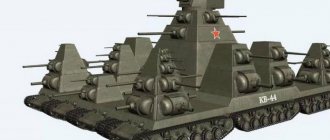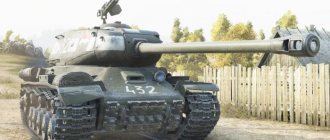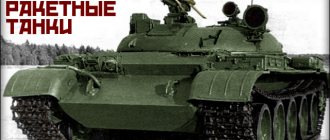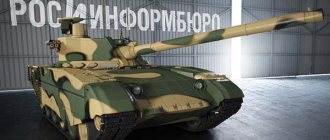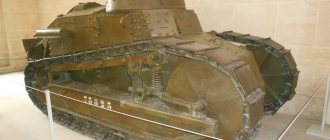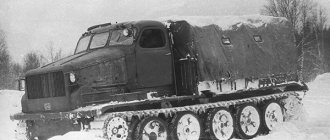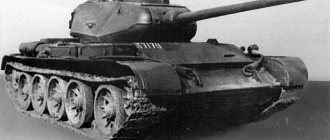True, the design of new armored vehicles was no longer carried out in Leningrad, but in Chelyabinsk, where most of the Kirov plant, including its tank design bureau, was evacuated.
Here is what is said about this in the book “Weapons of Victory” (Machine Building Publishing House, 1987): “In the ChTZ design bureau under the leadership of chief designer Zh.Ya. Kotin, in the winter of 1941-1942, work began on the design of promising modifications of the heavy tank: KV-7, KV-8 and KV-9.” And there was also the KV-13.
This seems incredible, but in the most difficult - the initial period of the war - the country's leadership did not object to experiments with tanks and even allocated considerable material and financial resources for this work.
KV-7 - three-gun version of the KV-1
Its design was original, but obviously unsuccessful. It was planned to install three 76-mm ZiS-5 cannons in the tank's turret. But with this installation, the tower could no longer rotate. The result was not a classic tank, but a self-propelled artillery mount - self-propelled guns.
However, in practice this idea was not realized either. It was decided to leave one 76-mm cannon and additionally install two 45-mm 20K cannons.
Six crew members were required to control and fire a self-propelled gun with three guns. Prototypes were assembled that showed good results during factory tests. But the military rejected the vehicle because they did not understand why self-propelled guns needed three guns aimed at one point at once.
By the way, some armies around the world are now armed with self-propelled guns with coaxial guns. Even in our country it was planned to make the Coalition self-propelled guns double-barreled.
Beginning of work
As mentioned earlier, the French model was taken as a sample. This tank was delivered to the Sormovsky plant, which was located in Nizhny Novgorod. On the territory of the enterprise, the machine was disassembled, thorough research was carried out, right down to measuring the dimensions of absolutely every part. In addition, the Izhora plant, as well as the Moscow AMO, took part in the creation of the first Soviet-designed tank. These factories supplied engines as well as armor. At the Sormovsky plant they were engaged in the production of the chassis and final assembly of the vehicle. Assembly of the first Soviet tank was completed in the winter of December 15, 1921. On this day, the vehicle was delivered to the regular army troops. After this, 14 more cars were assembled, which were called “Russian Renault”. What was the name of the first Soviet tank? The first car of its kind received the nickname “Freedom Fighter Comrade.” Lenin."
KV-8 became a flamethrower
In parallel with the work on the KV-7, the KV-8 flamethrower tank was being finalized, work on which began even before the start of the war - in the spring of 1941. It was planned to install the ATO-41 system as a flamethrower. The flamethrowing range with a standard mixture of fuel oil and kerosene was 60-70 meters, and with a viscous mixture - up to 110 meters. The weapon could fire both single shots and bursts of 4-5 volleys every 3 seconds, the one-time consumption of the mixture was approximately 10 liters.
However, the ATO-41 system did not fit into the KV-1 turret - the dimensions of the 76-mm F-32 gun got in the way. It was decided to replace it with a more compact 45 mm gun. To hide the weakness of the new gun from the enemy, a decorative casing-pipe was put on the gun, which created the appearance of a 76-mm caliber gun.
As a result, the KV-8 was able to accommodate the ATO-41 flamethrower, the ammunition of which included 107 ignition cartridges and 5 tanks with a combustible mixture - 2 in the turret, 1 in the fighting compartment and 2 in the transmission compartment. The total volume of the tanks was 960 liters. The car had to be serviced by a crew of four people.
In 1942, a significantly improved model of the flamethrower appeared - “ATO-42”. They also began to install it on a more advanced and faster modification - the KV-1S. Flamethrower tanks entered service.
A total of 102 KV-8 tanks and 25 KV-8S tanks were produced during the war years. These vehicles performed well in various battles. Including in the battle for Stalingrad. Flamethrower tanks did not become widespread, but they made their contribution to the overall Victory. In addition, at that time no army had such combat vehicles created on the basis of heavy tanks.
And how it all began
The term “fast tank” appeared precisely in the Soviet Union, in a country where the military doctrine of conducting military operations only on the territory of a potential enemy, quickly and swiftly, was adopted. This doctrine assigned the leading role to armored formations in subsequent military conflicts. The tank was now supposed to become not only a weapon to support infantry on the battlefield, but also turn into an independent offensive tool. Accordingly, new requirements were set for armored vehicles that would meet the assigned tactical tasks.
The Soviet Union was one of the first to make changes to the concept of development of armored tracked vehicles, creating wheeled-tracked tanks. According to the plan of the Supreme Military Leadership in the USSR, the army needed light, high-speed tanks, capable, unlike traditional self-propelled armored vehicles, of quickly covering long distances. For this it was planned to use a combined type of propulsion - wheeled-tracked, i.e. the vehicle moved over rough terrain on caterpillar tracks, but for driving on roads or in urban environments, the tank could use a wheeled propulsion type. The BT light tank, created by Soviet designers in the early 30s, was supposed to be just such a vehicle.
Tank Christie
The very idea of a wheeled-tracked tank was taken by Soviet designers from outside. Back in the 20s, American designer John Walter Christie managed to create an armored vehicle capable of simultaneously moving on tracks and on wheels. For this purpose, the vehicle's road wheels were made of the same diameter as car wheels. Accordingly, the rear rollers became driving wheels, and the front wheels could provide the necessary maneuver. Tracked, Christie's tank was a conventional armored vehicle capable of moving over rough terrain. With the tracks removed, the armored vehicle became a wheeled vehicle with two rear driving wheels. The most interesting thing is that when changing the method of movement, the tank did not have to be lowered or raised. To start moving at high speed, it was enough to remove the tracks and place them on special shelves.
The American tank was equipped with an aircraft engine, which allowed the vehicle to reach speeds of over 100 km/h when driving on wheels on a paved road. Despite the innovative technical and engineering solution, the US Army rejected the development of John Christie.
BT-2 first series
In the USSR, on the contrary, the development of the American was taken very seriously. During the trip of a representative group of Soviet designers and military personnel to the United States, two ready-made running platforms were purchased from John Christie, called “Original 1” and “Original -2”. In this form, the American development appeared at a tank training ground in the Soviet Union, where it was decided to conduct the first sea trials. The first results pleasantly surprised representatives of the military department. Wheeled-tracked vehicles showed good speed data, both when driving over rough terrain on tracks, and while running on the highway.
Why did a tank with this type of propulsion system become of interest to the Soviet military? The answer lies in the fact that the MS-1 tracked tanks existing at that time were not distinguished by their high speed of movement. The newer T-26 also had a limited range. For tank formations of that time, the main soreness was:
- insufficient motor resources;
- weak track base;
- small power reserve.
The weak material base and insufficiently reliable design did not allow tank formations to transfer under their own power from one deployment area to another. A wheeled-tracked tank could immediately solve these problems, making armored units highly mobile military formations. The result of testing prototypes was the conclusion of the Testing Department of the Automotive Tank Directorate of the Red Army on the prospects for further development of the high-speed BT-Christie tank in order to improve individual components and assemblies of the vehicles.
Original 1
The Kharkov Locomotive Plant became the base enterprise for the subsequent organization of production of a new tank for the needs of the Red Army. A year later, in May 1931, it was decided to begin construction to equip the Red Army with high-speed BT tanks of the Christie system. A new tank with the index BT-2 with a turret installed by Kharkov tank builders was put into production.
Thus, in the case of the Bateshki, the path from a prototype to a production vehicle was completed in just one year. The pace of establishing mass production in the Soviet Union was rapid. This applies not only to the BT tank, but also to its brother, the T-26 tracked tank, also purchased abroad from the British.
KV-9 - a tank that failed to achieve a breakthrough
Already at the end of 1941, the military demanded that the designers create a heavy tank with a powerful cannon. In Chelyabinsk, work began on the “Object 229”, which never became a production KV-9.
The main weapon chosen was the 122-mm separate-case-loading U-11 tank howitzer, created in December 1941 by engineers V. Sidorenko and N. Usenko.
The original designs of the KV-1 and KV-2 were adopted as the basis for the new tank. From the second version of the “KV” they took the chassis with a 600-horsepower diesel engine, torsion bar suspension and driving characteristics sufficient for a heavy tank. A slightly modified turret of the KV-1 tank was installed on it. The changes primarily concerned the dimensions of the window for installing the gun. Armor protection has been enhanced. The thickness of the frontal plate of the hull was increased to a huge 135 millimeters for those times. The forehead of the tower became even thicker - 210 millimeters. No tank in the world had such armor at that time.
In May 1941, “Object 229” with a 122-mm howitzer installed in its turret began field factory tests.
Tests immediately confirmed that powerful weapons allowed the new tank to effectively fight all types of armored vehicles the Germans had, in addition, the U-11 howitzer was very effective in destroying long-term firing points, dugouts and other fortifications.
The test results of the “Object 229” were considered successful, the vehicle was recommended for serial production and adoption under the name “heavy tank KV-9”. Unfortunately, only one pre-production tank was assembled. Due to a number of objective and subjective reasons, the KV-9 did not appear in the army and did not participate in battles.
The first tanks of the USSR photo
The first tanks of the USSR photo , in the late 1920s - early 1930s, there were two development concepts in the world. Thus, the French preferred small, slow-moving escort vehicles, as well as heavy, heavily armored ones, necessary for breaking through defensive lines. At the same time, the British designed mainly fast, lightly armed ones. They were ahead of the French in reducing the vulnerability of armored vehicles on the battlefield. In May 1930, military experts from the Department of Mechanization and Motorization of the Red Army, apparently considering the English concept more acceptable, entered into a contract with) for the supply of 15 double-turret Vickers-6-ton tanks. These vehicles served as a prototype for the creation of the first versions of our TMM-1 and TMM-2 tanks.
The Vickers Mk E served as a prototype for the creation of the first tanks of the USSR, interestingly, a large number of vehicles were ordered by Finland and China
- The first tanks of the USSR photo , TMM-1, were manufactured in 1931 as a modernized English version. Its body design was changed to accommodate a different engine - the American 6-cylinder Hercules ("Hercules") with a power of 94 hp. It replaced the English 4-cylinder 88-horsepower. The layout was classic for that time: the engine was in the stern, the transmission was in front. On the turret box of the hull there were two towers mounted on ball bearings. They could rotate independently of each other in a 240° sector, but in such a way that both towers could fire in both the front and rear sectors, equal to 100°, ensuring simultaneous firing from both sides.
Double-turreted T-26 early production with machine gun armament
7.62 mm DT-29 machine guns were placed in the ball joints of the front part of the turrets. They had a maximum sighting range of up to 1000 m with an effective range of 600 - 800 m; the combat rate of fire was 100 rounds/min. The machine guns were equipped with disc magazines with 63 rounds of ammunition. The bullets in the cartridges were armor-piercing, tracer, and armor-piercing tracer. Ammunition - 6489 pcs. in 103 discs. Aiming the machine guns was carried out very simply - with shoulder rests; The rotation of the turret was carried out by single-stage rotation mechanisms. In addition to the two turret 7.69 mm Vickers machine guns (later they were replaced by 7.62 mm), a third 7.62 mm DT machine gun was installed in the front hull plate on the right in a ball joint. The crew was accordingly increased to four people. The armor was strengthened, bringing the thickness of the frontal part of the hull to 20 mm, and the sides to 10 mm. As a result, the mass of the tank increased to 8 tons.
Performance characteristics of a LIGHT INFANTRY ESCORT TANK TMM-1 model 1932
- The turrets, the frontal part of the hull, and the sides had armor plates 13 mm thick,
- roof - 10 mm,
- bottom - 6 mm.
- In 1932, the armor thickness was increased to 15 mm. The weight increased to 8.2 tons.
- Ten TMM-1s were manufactured.
The first tanks of the USSR photo , TMM-2 had a 37-mm cannon in one of the turrets, and the third course machine gun was removed. Therefore, the crew was again reduced to three people. However, tests of the tanks did not show any advantages over the English Vickers. On the contrary, severe overheating of the American engine was revealed, which affected the mobility of already heavier vehicles, although the reinforced armor did not protect against artillery shells. The gearbox and turning mechanism did not work well. In September 1932, military specialists refused to carry out further modernization of the TMM, directing production capacity to develop the tank under the designation T-26.
Meanwhile, since 1931, Leningrad has been producing double-turret machine-gun tanks according to English drawings. The only difference between them and the prototype was that they were intended to be armed with DT machine guns in ball mounts, which is shown just above in the photo. By the end of 1931, 120 vehicles were manufactured, but due to low quality, none of them were initially accepted for military acceptance. Only after lengthy negotiations, according to various sources, 88 or 100 tanks were accepted, and 35 of them conditionally, since their hulls were made of non-armored steel. However, in September of the same year, the Defense Committee approved a production program for 3,000 T-26 units for 1932, although most production was still far from ready.
Cannon-machine gun tank with a 37 mm B-3 cannon and a 7.62 mm DT machine gun
In 1932, all tank production and the experimental design engineering department (OKMO) were transformed into the Leningrad State Plant No. 174 named after K.E. Voroshilov, who became a long-term supplier of T-26s to the army. In October, the People's Commissariat of Heavy Engineering established the Special Engineering Trust "for better organization of tank production." It included about 15 related enterprises. These included, in addition to plant No. 174, the Izhora plant, which produced armored hulls and turrets: “Red October,” which produced gearboxes and driveshafts; "Krasny Putilovets", responsible for the supply of the chassis; Plant No. 37, which supplied boiler-tin products and other components. It was planned to involve the Nizhny Novgorod Automobile Plant (future GAZ) and Joint Stock Moscow Company (AMO, future ZIL) in the production of engines.
- By March 1933, Plant No. 174 managed to assemble 1,441 T-26 tanks , 950 of which immediately went to army units (according to other sources, by August 1933, 1,626 double-turret tanks were produced).
Since the first releases, changes have been constantly made to the design of the T-26. So, already in the fall of 1931, a cylindrical higher machine gun turret with an observation window was installed on it. Then the engine was moved 0.77 m to the stern to improve its operating conditions. True, for this it was necessary to lengthen the driveshaft, and also change the outlet and mounting of the muffler. Early next year they replaced the oil and fuel tanks with new ones. A box was placed above the air outlet blinds to protect the engine from precipitation.
T-26 tank with riveted hull and turret. Armed with a 45 mm 20K cannon and a 7.62 mm machine gun. Tank Museum, Parola, Finland
Initially, the tank hull was riveted - riveting 6 - 13 mm sheets was done on the frame. But at the beginning of 1932, they managed to produce 22 vehicles with welded hulls, although they continued to produce solid-riveted hulls and turrets in parallel. The engine was installed T-26 - a 90-horsepower gasoline, 4-cylinder air-cooled engine with a special fan, which allowed it to reach highway speeds of up to 32 km/h. The specific power of the tank is 11.2 hp/t. The gas tank held 182 liters of high-grade (at that time) gasoline with a cruising range of 140 km.
The power transmission consisted of a single-disc main dry friction clutch. The five-speed gearbox was located in the front of the tank - the driveshaft from the engine passed through the entire body; The gear shift lever was on the box itself. The chassis had two bogies on board, consisting of four dual rubber-coated road wheels in each. The bogies were suspended on two quarter-elliptical leaf springs; the rollers were connected in pairs by balancers. The drive wheels with removable gear rims were front. Track chains made of chromium-nickel or manganese steel - 260 mm wide.
Linear gun tank T-26 model 1933 with a cylindrical turret with a 45-mm cannon
The T-26 machine gun crew consisted of three people: a driver, a left turret gunner, and a commander who combined the functions of a right turret gunner.
In 1932, in parallel with machine-gun tanks, they began to produce double-turret machine-gun-cannon tanks - now a Hotchkiss cannon was installed in the right turret; it was a model 1880 naval gun converted by the French - a variant for a tank. Our artillery designer P. Syachentov improved its firing and trigger mechanisms: in this form it was adopted for service in 1920 under the designation PS-1 (“Syachentov Gun-1”),
The gun had a 22.7 klb long monoblock barrel, a vertical wedge bolt, and a spring knurl. In the vertical plane it was aimed manually using a shoulder rest within +30°, in the horizontal plane - by turning the turret. However, the gun had low efficiency when firing at both infantry and armored targets - solid cast iron shells, cast iron and steel grenades and buckshot served as ammunition. In 1932, its production was stopped.
In the same year, it was put into service under the name “37-mm anti-tank gun mod. 1930" and the factory index 1-K adopted the German 3.7-st RaK 35/36 gun. . The same designer P. Syachentov developed a project for installing its swinging part in a tank - the result was the PS-2 tank gun. Already on its basis, a new version of the 37-mm cannon was developed, designated B-3 (index - 5-K); it had a smaller recoil and knurl size, which made it possible to install it in the standard T-26 turret.
The turret of a tank model 1933. In the center is the breech of a 45-mm cannon and its aiming mechanisms, on the right is a machine gun and a TOP sight, to the left of the gun is a PT-1 sight
The weight of the machine-gun-cannon tank increased to 8.7 tons with 15 mm armor on the frontal part of the hull and sides. The ammunition load in such a vehicle was 113 pieces, 7.62 mm cartridges - 3528 pieces.
In May 1932, the 45-mm cannon model was adopted to replace the 37-mm anti-tank gun. 1932 (index 20K), and later - its modernized version 20K mod. 1932/34 In terms of armor penetration, it had characteristics comparable to the 37 mm, but its 0-240 high-explosive fragmentation projectile turned out to be much more powerful due to an increase in the mass of the explosive (from 22 g to 118 g). This made it possible to use the tank much more effectively in the fight against enemy personnel, and therefore as an escort and infantry support vehicle.
Performance characteristics and armor penetration of the 20K model gun. 1934 on T-26
However, the 20K gun was relatively large and did not fit in the existing T-26 turrets. To do this, it would be necessary to introduce a balancing mechanism, a new lifting guidance mechanism, leaving only one crew member in the turret. Therefore, in March 1933, at plant No. 174, a new cylindrical turret with an outer diameter of 1320 mm with an increased internal volume and an aft niche formed by the continuation of the side plates of the turret was installed on the T-26 hull as a counterweight; The niche also served for stowing ammunition. In the roof of the turret there was a hatch for the crew to get in and out, and in a niche there was a hatch for dismantling the gun.
The cannon, coaxial with a machine gun, was placed on trunnions in the frontal part of the turret, with a massive mantlet. It had a barrel length of 46 klb (2070 mm) with a free replaceable pipe - liner, a vertical wedge shutter, recoil guards with hydraulic recoil brakes, and spring knurls. The rollback length was 245 - 275 mm.
The gun was aimed vertically by a sector mechanism with angles from -5° to +26°; in the horizontal plane, circular fire could be carried out by rotating the turret using a screw rotating mechanism. The gunner used a panoramic periscopic optical sight PT-1 mod. 1932 and a telescopic optical sight TOP mod. 1930 PT-1 had an aiming reticle designed to fire armor-piercing shells at a range of up to 3.6 km, fragmentation shells - up to 2.3 km, and a coaxial machine gun - up to 1.6 km. The TOP had the same grid, but designed for ranges of up to 6.4 km, 3 km and 1 km, respectively. The magnification of both devices was 2.5 times.
Tank T-26 mod. 1933 with 45 mm cannon
Gun 20K mod. 1932/34 the first series was semi-automatic - the automation only worked when firing armor-piercing shells. When firing high-explosive fragmentation weapons, only the bolt was automatically closed after inserting a projectile into the breech, while the bolt was opened and the cartridge case was extracted manually. The new semi-automatic inertial type and modified recoil guards were able to be installed only by 1935.
The 20K cannon of the T-26 tank was intended to fire at armored targets and artillery pieces, and at enemy personnel (open and in shelters) with both armor-piercing and high-explosive fragmentation shells. It had excellent tactical and technical characteristics for that time. Thus, the maximum firing range was 4200 m with a direct shot distance of 3600 m. The BR-240SP armor-piercing projectile weighing 1.43 kg, having an initial speed of 760 m/s, at a distance of 500 m, penetrated armor 45 mm thick, and at 1500 m - 28 mm. The gun's rate of fire is 7 - 12 rds/min.
ARMOR PENETRATION CANNON 20K mod. 1934 PROJECTILE BR-240SP (mm)
Performance characteristics and armor penetration of the B-3 tank gun
The ammunition consisted of 136 rounds and 2898 machine gun cartridges in 46 magazines. 84 rounds were placed in the fighting compartment, 40 were located in the turret niche, and another 12 were placed directly in the turret itself along its sides. 40 machine-gun magazines were placed in boxes on the floor of the hull, another 6 were located on the right side of the turret in a special rack. The single-turret hull was not much different from the double-turret one. The turret plate on which the turret was installed, shifted to the left, has changed. The fighting compartment was equipped with a fan, placing it on the right side near the roof of the fighting compartment, since during firing the concentration of carbon dioxide in the tank increased unacceptably.
Since 1933, the T-26 began to be equipped with radio stations 71-TK-1 (later - 71-TK-2, 71-TK-Z) with a handrail antenna. This is a short-wave transmitting and receiving telephone and telegraph station, the receiver and transmitter of which are made in the form of separate blocks. To protect against shaking, the receiver and transmitter were installed on special frames with shock absorbers. The stations allowed joint operation with tank intercoms. The communication range by telephone was 10 - 30 km while driving and up to 40 km when parked with the engine not running. The transmitter was powered by a starter battery through an umformer and could operate continuously for 30 minutes, after which a half-hour break was required to cool down. The receiver operated from two dry anode batteries with a voltage of 80 V each and an alkaline battery; The duration of its operation from one set of batteries was 15 - 20 hours. The weight of the radio station was 60 kg.
Radio tank T-26 with a handrail antenna of the shortwave radio station 71-TK-1
The handrail antenna was a half-ring made of a metal pipe, mounted around the tower on insulating brackets. However, as it turned out, in combat conditions such an antenna unmasked radio-equipped command vehicles, and the enemy concentrated anti-tank fire on them. In the course of further modernizations, this type of antenna was abandoned in favor of a whip one.
In 1935, the plant completely switched to electric-welded hulls and turrets, and the gun mantlet began to be produced by stamping. In the same year, a second DT machine gun was placed in the rear turret on an additional ball mount. At the same time, the ammunition load was reduced to 102 rounds.
The following year, the T-26 received a DT anti-aircraft machine gun on a P-40 turret mounted on the roof of the turret. Two powerful “combat light” spotlights were placed on the mask, designed for combat operations at night. The engine was boosted - maximum power increased to 95 hp.
TTX T-26 of various years of production
The first meeting of these armored vehicles took place in rebellious Spain in 1936. In September of this year, 41 German Pz-1 tanks arrived here. A month later, 50 T-26 tanks were delivered on the Komsomolets steamship. In the very first combat contacts, a significant advantage of Soviet vehicles was revealed. The 45-mm 20K cannon penetrated through Pz-1s at any range, which only had a pair of 7.92-mm machine guns, which was of little danger to our vehicles - the T-26’s armor was also more powerful. In 1938, the Germans sent here their new Pz-lls, which had 20-mm cannons and slightly increased armor. However, they were also unable to fight our tanks, which hit them at a range exceeding even one kilometer. The Pz-ll could respond only from a short distance, and only with a successful hit.
By that time, no other country had created a tank equal to our T-26 . “It was a magnificent tank for its time: a low silhouette, easy to manufacture and operate, well armed and protected for its size,” noted the famous military historian P. Chamberlain.
The first tanks of the USSR photos , the most important dates
- The T-26 light infantry tank was put into service in 1931, but serial production began only in 1933. Work on it began with the Decree of the Central Committee of the All-Union Communist Party of Bolsheviks “On the State of Defense of the USSR” dated July 15, 1929, which indicated the need to develop new types of military equipment, including tanks. According to the plan of the Revolutionary Military Council, the army needed a combat unit that could “become the main striking force of mobile units in conditions of maneuverable combat.” The armament was supposed to provide it with “superiority over all known combat vehicles of similar mass, and the armor would protect against rifle and machine-gun bullets at all distances, and at a distance of 1000 m, from the fire of 37-mm anti-tank guns.”
- In 1938, as a result of another modification, a conical turret appeared, welded from rolled armor sheets 15 mm thick. It was equipped with a 45-mm cannon mod. 1938 with an electric shutter, which made it possible to fire ammunition with an electric primer sleeve. The gun was equipped with a TOS telescopic sight, stabilized in the vertical plane. They installed two fuel tanks with a total capacity of 290 liters, increasing the range to 240 km. An emergency hatch appeared in the bottom.
- In 1939, a turret box with inclined sheets was made and new blinds with enhanced protection were installed. Now they had removed the turret-mounted aft machine gun and again returned to the aft niche with the stacking of shots. The engine was brought to a power of 97 hp.
- 1940 - the year of the last, 23rd modification of the T-26. This time, 30-40 mm protective screens appeared on the tanks. They made it possible to withstand hits from 45-mm cannon shells at a distance of 400 - 500 m. The thickness of the turret box sheets was increased to 20 mm, and a new turret ring was installed.
- Over all the years of serial production of T-26 tanks of various modifications, 11,218 units were manufactured . In addition, OT flamethrower tanks, TP armored personnel carriers, ST bridge layers, TV transporters, T artillery tractors, and SU and AT self-propelled artillery units were produced on the same chassis. As it turned out, the chassis was unified for a whole family of combat vehicles.
As part of the Red Army, T-26s first participated in the operation to repel the advance of Japanese troops into the territory of the USSR in the area of Lake Khasan in July - August 1938, where more than 250 of these tanks operated.
A unit of T-26 tanks before entering the concentration area. Khalkin-Gol, July 1939
In May - September 1939, T-26s were used to resolve the military conflict on the Khalkin-Gol River. Thus, the tank battalion of the 36th motorized rifle division consisted of 50 vehicles. The 11th Tank Brigade consisted of OT-26 flamethrower tanks, and a separate tank company of OT-130 flamethrower tanks.
Since 1940, each rifle division had tank battalions with 54 T-26 vehicles (15 of them flamethrowers). Each rifle regiment had a tank company with 17 T-26s. There were also light tank brigades armed with BTs or T-26s. In total, there were 17 brigades with 267 units from the T-26. Seven tank regiments with T-26s of 164 vehicles each were also formed, which were included in some motorized rifle and motorized divisions. As part of such units, the first tanks of the USSR photo T-26 participated en masse in the Soviet-Finnish War of 1939 - 1940, showing high combat qualities.
According to the publication “Strategic collection No. 1. Combat and numerical strength of the Armed Forces of the USSR during the Great Patriotic War,” published in 1994, as of June 1, 1941, the Red Army had more than 9998 T-26 tanks of all modifications (about 40 % of the entire tank fleet of the Red Army), of which 8423 are serviceable. Together with the BT, they turned out to be the main tanks that resisted the advancing units of the German army in the initial period of the war, especially in the battles near Moscow. What is interesting, contrary to popular belief, here, as in Spain, the German Pz-I and Pz-ll, produced even in recent years, could not match the level of our vehicles, not taking into account the T-34 and heavy KV.
The crew of the T-26 on the left in the turret is the tank commander, on the right is the gunner, in the open hatch the mechanic is the driver. Spotlights are installed above the gun mantlet for combat operations at night.
The T-26 completed its military service in the Soviet Army. In the army units that guarded our border with Japanese-occupied Manchuria during the war, many T-26s and BTs were preserved. These vehicles took part in the military operation to defeat the Kwantung Army of Japan in 1945.
The T-26 fully corresponded to its purpose. Its armament, maneuverability, and maneuverability fully met the requirements for light infantry tanks. There was nothing equal, or even close, in any other country at that time (meaning the mid and late 30s). An interesting fact, for example, the English Vickers, which served as the starting point for the creation of its own tank developments in the USSR, was in service with the Finnish troops until 1958 (!).
MS-1 model 1927 and 1930
The first Soviet tank, model MS-1, was ready in May 1927. This sample was obtained by eliminating the shortcomings that the T-16 model had. The following points were significant differences: the tank hull was lengthened, an improved engine model was installed, and the suspension was improved. This tank was tested at the state level in June of the same year, they ended successfully. Serial production of the MC1 or T-18 models began in February of the following year at. In November 1929, a company of these models, consisting of 9 samples, took part in hostilities on the Chinese Eastern Railway.
In 1929, the MS-1 model was modernized. A new engine was installed, as well as a gearbox. In addition, a cast drive wheel was installed, as well as tracks with cast tracks. The tank also received a new turret, which had a rear niche intended for mounting the PS-2 gun. There were also plans to install a radio station on this tank. It is also worth adding that by that time the model of this tank was no longer considered promising, but despite this fact, it was adopted by the Red Army.
Description of the first Soviet-made cars
As already mentioned, the name of the first Soviet tank was “Russian Renault”. The decision to build this model was made at a meeting on August 10, 1919. The drawings for this model were developed with the participation of the Soviet engineer Kalinin, as well as the French engineers Dem and Rosier. The engine for the tank was manufactured at the Moscow AMO, and the original model was a sample from the same Renault FT. The first tests of the Freedom Fighter Comrade vehicle. Lenin" were held in 1920 on August 31. The full series included 15 vehicles, which were built and delivered in May 1921. These units did not take part in combat battles, and in April 1930 they were completely withdrawn from service. An interesting fact about these models is that each of them had its own name.
The second attempt to invent a tank was the T-16, which was made on the basis of the Italian Fiat-3000. Several engineers took part in the development. Their brainchild passed its first tests in March 1927. However, the unit did not have the characteristics that were originally planned, and therefore its tests were postponed.
Models of heavy vehicles
At the end of the 30s. last century, the USSR was guided by two principles: the first was the construction of light and maneuverable tanks, and the second was the construction of heavy models with a large number of towers (from three to five), with a large number of various weapons installed on these towers.
In the same year, the Bureau of the Ordnance-Weapons-Machine-Gun Association, which acted as the main design body, entered into a contract with the leadership of the Red Army to create the first Soviet heavy tank, intended to break through the fortified enemy defenses. The weight of this vehicle was supposed to be 50 tons, and the model was supposed to have two 76 mm cannons and five machine guns as its main guns. The car number was T-30. However, difficulties arose here, since it was not possible to implement this project in the vastness of the USSR at that time. In 1932, all work was stopped altogether, since the T-30 tank project was declared unsatisfactory for its use as a combat vehicle.


